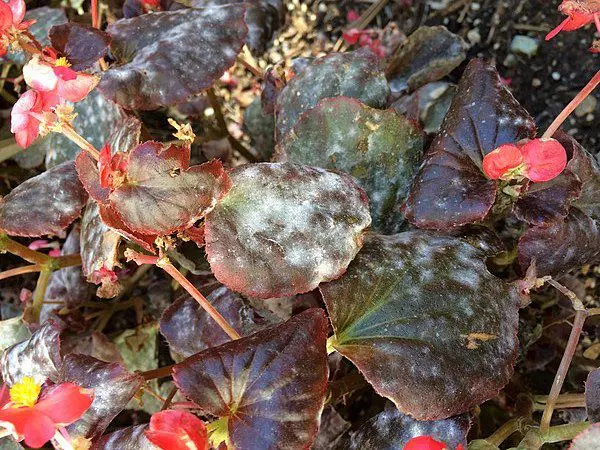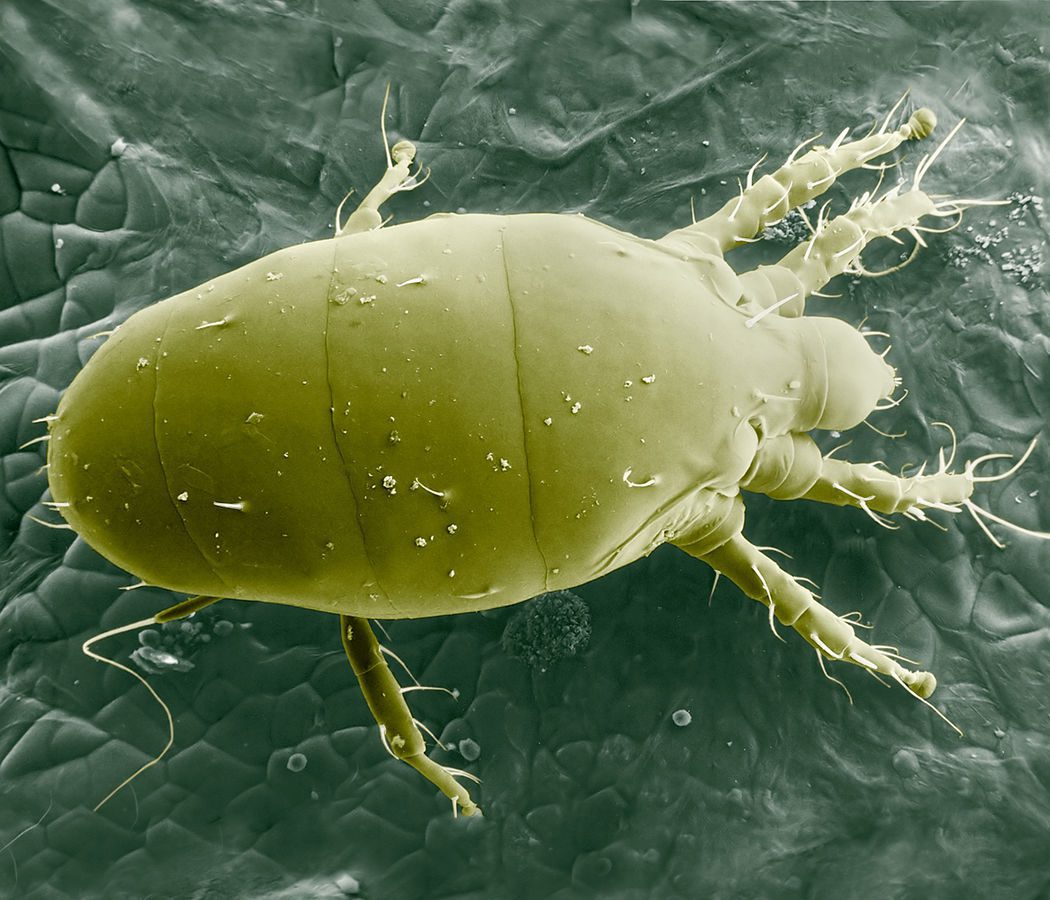Identifying pests and diseases on begonias can be taxing. Hopefully, this information will aid you in being a Pest and Disease Detective. Some pests that could affect your begonias are mites, mealybugs, scale, whiteflies, nematodes, and slugs/snails
There are two types of mites to consider, the broad mite and the Begonia mite. You will know that you have broad mites when young leaves are rolled, brittle and discolored. Remove and destroy the infected parts and be sure to spray with a good miticide. Other types of mites can attack begonias as well. The first sign of these mites will be yellow speckling on infested leaves. The application of a miticide is as critical here as with the two previous mites. Greenhouses often have a problem with mites. Spray new plants with a miticide that will kill all phases of the mite.
The broad mite Polyphagotarsonemus latus | Photo: Public Domain, Click here
Mealy bugs are very common. The body of a mealybug is soft, white, and wax-like. A “wooly” material is secreted around its egg masses. A cotton swab saturated with rubbing alcohol usually controls a single site infestation. If the area is large, spraying or dipping in soapy water will be the method of control. Several treatments may be required to eradicate this critter.
Scale are small, roundish insects with a hard shell on their outer surface. Two kinds of scale may be found on begonias: soft and hard. Soft scale produces a honey-like residue. Hard scale has “armor” on its back and doesn’t produce any residue. The treatment of this insect is the same as mealy bugs. Treat infections at regular intervals, until scale is gone.
White flies are very small, white insects that can fly. They are found on the undersides of leaves and, if disturbed, will fly to other plants. Yellow, sticky traps suspended near the plant will attract and catch them. A soapy water spray is also effective. Spray 6–10 days apart to kill the larvae that are constantly hatching. Chemical sprays can be useful as well. Predatory wasps may be beneficial in a greenhouse setting.
Nematodes are parasitic, microscopic worms that come in two types: leaf and root. Leaf nematodes are a problem in terrariums or greenhouses due to their need for a moist, humid environment. This setting is prime for them to move from plant to plant. Reddish-brown, dead areas on leaves and stunted growth are signs that this nematode may be present. Practice good plant care by removing dead and decaying leaves from plants as well as from growing racks and benches. Avoid overhead watering and wetting the leaves. Root nematodes are soil-borne and attack the begonia’s root system. This often leaves the foliage void of substance, discolored, distorted, or wilting. These plants should be destroyed. A reliable method to stop the transfer of these pests is to sterilize the pots or application of a soil drench if they are in infected soil.
A telltale sign of a slug or snail in your Begonia garden outdoors is the presence of mucus and round holes in the leaves. They can be controlled by applying diatomaceous earth around the base of the plant in a 2” wide circle. Traps and pellets will be more practical for a profuse infestation.
Diseases
Some diseases that could affect your begonias are bacterial leaf spot, powdery mildew, botrytis, Pythium root rot, and rhizoctonia crown rot.
Some signs that your plant may have bacterial leaf spot are water-soaked areas on leaves surrounded by yellow rings. Some stem rot may also be present. Most noticeable in the summer when conditions are warm and humid, and rainfall is high.
Remove and destroy any infected leaves and spray, if necessary, with a bacterial leaf spray. The best control is to refrain from introducing an infected plant into your collection.
Hygiene is first and foremost in preventing bacterial infection, cleaning scissors or hands after handling sick plants – and treatment with copper-based sprays is the only cure, they come in both “organic” and non-organic forms. Read more about Bacteria and Virus Infections in begonias.

Begonia semperflorenswith powdery mildew | Photo: Scot Nelson from USA, CC0, via Wikimedia Common
Powdery mildew is a white, powdery substance on the topside of leaves, buds and stems. This type of mildew is usually present when the temperature is cool, and the humidity is high. Good air circulation and plenty of ventilation are a must for a greenhouse grower. A good fungicide may be used if conditions call for a more definitive control.
Botrytis is gray, moldy patches on leaves, stems and buds. This disease prefers cool, wet or humid conditions. It occurs on dead or dying plant material. Treat by providing good ventilation inside and by spacing out plants for good airflow in an outside garden. Always remove dead or dying leaves or flowers. Spray infected plants with a good fungicide, if necessary.
Pythium root rot is a fungus that will attack roots and stems of adult plants and cuttings. There may be a slight wilting of the plant followed by the yellowing of lower leaves. This eventually leads to roots and stems turning black and mushy, with the demise of the plant shortly thereafter. It is important to sterilize pots and spray with a fungicide. Cuttings should not be given a lot of water and need excellent drainage as well.
Rhizoctonia crown rot is the presence of brownish mold spreading from the soil to infect the stem base. This will eventually kill the stem. This disease is normally found on plants that have been damaged or stressed by high temperatures. Good horticultural practices and cleanliness will help prevent this disease. Application of a fungicide is also recommended.
Edited from The Begonian, Ed MacFarland’s article- March/April 2021


